Bristol Bay Area
Subsistence Fishing
Fishing Information
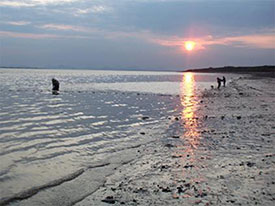 Finfish in Bristol Bay may be taken for subsistence purposes only by Alaskan residents. To subsistence fish for salmon one subsistence salmon permit per household per year is required. The total salmon harvest by all members of the household must be recorded on the permit and returned to ADF&G at the end of the season. Subsistence Salmon permits are issued free of charge.
Finfish in Bristol Bay may be taken for subsistence purposes only by Alaskan residents. To subsistence fish for salmon one subsistence salmon permit per household per year is required. The total salmon harvest by all members of the household must be recorded on the permit and returned to ADF&G at the end of the season. Subsistence Salmon permits are issued free of charge.
Set gillnets are legal throughout the area to fish for salmon. Set nets are anchored on both ends of the net, one end on shore above high tide and the opposite end extending perpendicular to the shore and anchored in the water. Set nets must be staked and buoyed. By regulation net lengths are restricted to 10 or 25 fathoms (one fathom = 6 feet) and the legal distance between nets is 100, 300 or 450 feet depending on the fishing location. In some limited areas drift gillnets, beach seines, spears and dip nets are legal — check the regulations to be sure you are fishing legally.
Salmon
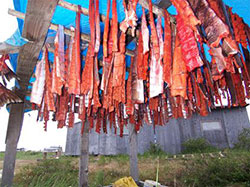
There are 5 Commercial Salmon Fishing districts in the Bristol Bay area: Ugashik, Egegik, Naknek/Kvichak, Nushagak and Togiak. In the commercial districts from May 1 through May 31 and October 1 through October 31 subsistence salmon fishing is allowed from 9 AM Monday through 9 AM Friday. From June 1 through September 30 within the waters of a commercial district salmon may be taken only during open commercial fishing periods. A person may not subsistence fish and commercial fish simultaneously. In the Nushagak Commercial District emergency order subsistence salmon fishing openers are announced during periods of extended commercial closures. The announcements can be heard on KDLG 670 AM radio or by calling (907) 842-5226 for recorded messages. Check the regulations for methods and means of harvest during emergency order openings.
In the Naknek, Kvichak, Egegik and Ugashik Rivers, upriver of the commercial districts, salmon may be taken at any time unless changed by Emergency Order. Fishermen must be Alaskan residents, possess an annual subsistence permit, and a properly marked set gillnet. In the Naknek River there is a special area for Elders. In the Naknek River drainage upstream of Savonaski from June 1 to October 1 gillnets are prohibited except in limited areas of the Naknek Lake by specific regulations. In the area of the Nushagak River from Nushagak Point (the northern boundary of the Nushagak commercial salmon fishing district) to Lewis Point and including the lower Wood River upstream to Red Bluff, subsistence fishing for salmon from 9 AM July 2 to 9 AM July 17 is limited to three 24 hour fishing periods per week. Each period starts a 9 AM on Monday, Wednesday and Saturday and ends at 9 AM the following day.
Non-Salmon Finfish
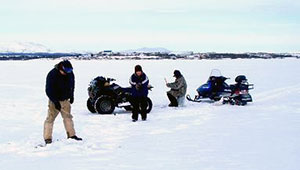 Nets may be used to catch non-salmon finfish for subsistence purposes but other regulations also apply. Fishing through the ice with a hook and line attached to a rod or pole is legal for subsistence fishing. Rainbow trout may not be targeted for subsistence but rainbows caught incidentally while fishing for other species may be kept for subsistence purposes. Permits are not required to fish for non-salmon finfish. Smelt, Dolly Varden and pike are favorite subsistence fish caught in the winter by ice fishing.
Nets may be used to catch non-salmon finfish for subsistence purposes but other regulations also apply. Fishing through the ice with a hook and line attached to a rod or pole is legal for subsistence fishing. Rainbow trout may not be targeted for subsistence but rainbows caught incidentally while fishing for other species may be kept for subsistence purposes. Permits are not required to fish for non-salmon finfish. Smelt, Dolly Varden and pike are favorite subsistence fish caught in the winter by ice fishing.
Halibut
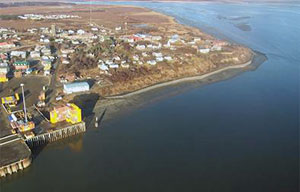 Under State regulations halibut may be taken with a single hand line with no more than two hooks attached. The daily bag limit for halibut is two, and the possession limit is two daily bag limits (four fish). No person may possess sport-taken and subsistence - taken halibut on the same day. Rural residents of Bristol Bay and Alaska Native Tribal members who obtain a Subsistence Halibut Registration Certificate (SHARC) from NOAA are allowed to fish under a set of regulations with a more liberal bag limit and gear type. More information about the SHARC program, including application forms can be found at: http://www.fakr.noaa.gov/ram/subsistence/halibut.htm.
Under State regulations halibut may be taken with a single hand line with no more than two hooks attached. The daily bag limit for halibut is two, and the possession limit is two daily bag limits (four fish). No person may possess sport-taken and subsistence - taken halibut on the same day. Rural residents of Bristol Bay and Alaska Native Tribal members who obtain a Subsistence Halibut Registration Certificate (SHARC) from NOAA are allowed to fish under a set of regulations with a more liberal bag limit and gear type. More information about the SHARC program, including application forms can be found at: http://www.fakr.noaa.gov/ram/subsistence/halibut.htm.
Shellfish
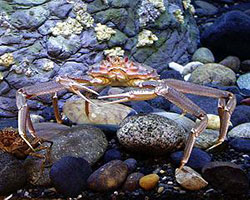 In areas where shell fish are present and accessible they are harvested locally for subsistence by knowledgeable individuals. Cockles and clams are harvested throughout the Bristol Bay area in relatively small amounts. Broad subsistence shellfish regulations restrict daily bag and possession limits per person for: Dungeness crab (12), King crab (6) and Tanner crab (12). For these three species only males may be taken. In the Bristol Bay area the subsistence harvest of crabs is negligible.
In areas where shell fish are present and accessible they are harvested locally for subsistence by knowledgeable individuals. Cockles and clams are harvested throughout the Bristol Bay area in relatively small amounts. Broad subsistence shellfish regulations restrict daily bag and possession limits per person for: Dungeness crab (12), King crab (6) and Tanner crab (12). For these three species only males may be taken. In the Bristol Bay area the subsistence harvest of crabs is negligible.
Unattended subsistence fishing gear must be identified. Buoys inscribed with first initial, last name and address are legal. The alternative and preferred method of identifying gear for subsistence salmon fishing is a sign staked at the set net site inscribed with the first initial, last name and subsistence salmon permit number of the permit holder.
